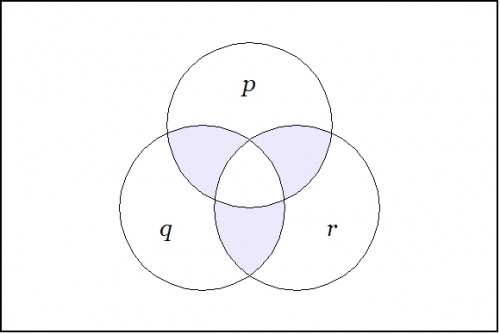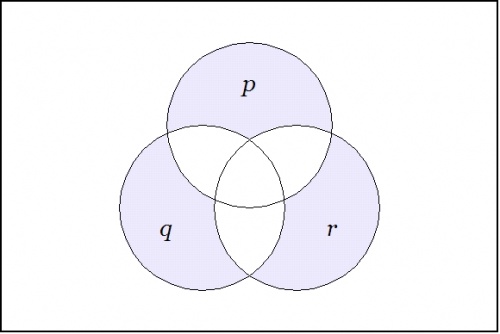Difference between revisions of "Minimal negation operator"
Jon Awbrey (talk | contribs) |
Jon Awbrey (talk | contribs) (to hedge a bet) |
||
| Line 44: | Line 44: | ||
|} | |} | ||
| − | If we think of the point <math>x = (x_1, \ldots, x_k) \in \mathbb{B}^k</math> as indicated by the boolean product <math>x_1 \cdot \ldots \cdot x_k</math> or the logical conjunction <math>x_1 \land \ldots \land x_k,</math> then the minimal negation <math>\texttt{(} x_1, \ldots, x_k \texttt{)}</math> indicates the set of points in <math>\mathbb{B}^k</math> that differ from <math>x\!</math> in exactly one coordinate. This makes <math>\texttt{(} x_1, \ldots, x_k \texttt{)}</math> a discrete functional analogue of a ''point omitted neighborhood'' in analysis, more exactly, a ''point omitted distance one neighborhood''. In this light, the minimal negation operator can be recognized as a differential construction, an observation that opens a very wide field. It also serves to explain a variety of other names for the same concept, for example, ''logical boundary operator'', ''limen operator'', '' | + | If we think of the point <math>x = (x_1, \ldots, x_k) \in \mathbb{B}^k</math> as indicated by the boolean product <math>x_1 \cdot \ldots \cdot x_k</math> or the logical conjunction <math>x_1 \land \ldots \land x_k,</math> then the minimal negation <math>\texttt{(} x_1, \ldots, x_k \texttt{)}</math> indicates the set of points in <math>\mathbb{B}^k</math> that differ from <math>x\!</math> in exactly one coordinate. This makes <math>\texttt{(} x_1, \ldots, x_k \texttt{)}</math> a discrete functional analogue of a ''point omitted neighborhood'' in analysis, more exactly, a ''point omitted distance one neighborhood''. In this light, the minimal negation operator can be recognized as a differential construction, an observation that opens a very wide field. It also serves to explain a variety of other names for the same concept, for example, ''logical boundary operator'', ''limen operator'', ''least action operator'', or ''hedge operator'', to name but a few. The rationale for these names is visible in the venn diagrams of the corresponding operations on sets. |
The remainder of this discussion proceeds on the ''algebraic boolean convention'' that the plus sign <math>(+)\!</math> and the summation symbol <math>(\textstyle\sum)</math> both refer to addition modulo 2. Unless otherwise noted, the boolean domain <math>\mathbb{B} = \{ 0, 1 \}</math> is interpreted so that <math>0 = \operatorname{false}</math> and <math>1 = \operatorname{true}.</math> This has the following consequences: | The remainder of this discussion proceeds on the ''algebraic boolean convention'' that the plus sign <math>(+)\!</math> and the summation symbol <math>(\textstyle\sum)</math> both refer to addition modulo 2. Unless otherwise noted, the boolean domain <math>\mathbb{B} = \{ 0, 1 \}</math> is interpreted so that <math>0 = \operatorname{false}</math> and <math>1 = \operatorname{true}.</math> This has the following consequences: | ||
| Line 336: | Line 336: | ||
\text{or} & e_j & = & \nu (x_j), | \text{or} & e_j & = & \nu (x_j), | ||
\\[6pt] | \\[6pt] | ||
| − | \text{for} & j & = & 1 | + | \text{for} & j & = & 1 ~\text{to}~ k. |
\end{array}</math> | \end{array}</math> | ||
|} | |} | ||
| Line 388: | Line 388: | ||
[[Category:Combinatorics]] | [[Category:Combinatorics]] | ||
[[Category:Computer Science]] | [[Category:Computer Science]] | ||
| + | [[Category:Differential Logic]] | ||
| + | [[Category:Equational Reasoning]] | ||
[[Category:Formal Languages]] | [[Category:Formal Languages]] | ||
[[Category:Formal Sciences]] | [[Category:Formal Sciences]] | ||
Revision as of 18:36, 25 August 2009
The minimal negation operator \(\nu\!\) is a multigrade operator \((\nu_k)_{k \in \mathbb{N}}\) where each \(\nu_k\!\) is a \(k\!\)-ary boolean function defined in such a way that \(\nu_k (x_1, \ldots , x_k) = 1\) for just those cases where exactly one of the arguments \(x_j\!\) is \(0.\!\)
In contexts where the initial letter \(\nu\!\) is understood, the minimal negation operators can be indicated by argument lists in parentheses. In the following text a distinctive typeface will be used for logical expressions based on minimal negation operators, for example, \(\texttt{(x, y, z)}\) = \(\nu (x, y, z).\!\)
The first four members of this family of operators are shown below, with paraphrases in a couple of other notations, where tildes and primes, respectively, indicate logical negation.
|
\(\begin{matrix} \texttt{()} & = & \nu_0 & = & 0 & = & \operatorname{false} \'"`UNIQ-MathJax1-QINU`"' * The point \((0, 0, \ldots , 0, 0)\) with all 0's as coordinates is the point where the conjunction of all negated variables evaluates to \(1,\!\) namely, the point where:
To pass from these limiting examples to the general case, observe that a singular proposition \(s : \mathbb{B}^k \to \mathbb{B}\) can be given canonical expression as a conjunction of literals, \(s = e_1 e_2 \ldots e_{k-1} e_k\). Then the proposition \(\nu (e_1, e_2, \ldots, e_{k-1}, e_k)\) is \(1\!\) on the points adjacent to the point where \(s\!\) is \(1,\!\) and 0 everywhere else on the cube. For example, consider the case where \(k = 3.\!\) Then the minimal negation operation \(\nu (p, q, r)\!\) — written more simply as \(\texttt{(p, q, r)}\) — has the following venn diagram:
For a contrasting example, the boolean function expressed by the form \(\texttt{((p),(q),(r))}\) has the following venn diagram:
Glossary of basic terms
See alsoTemplate:Col-break
External links
|

